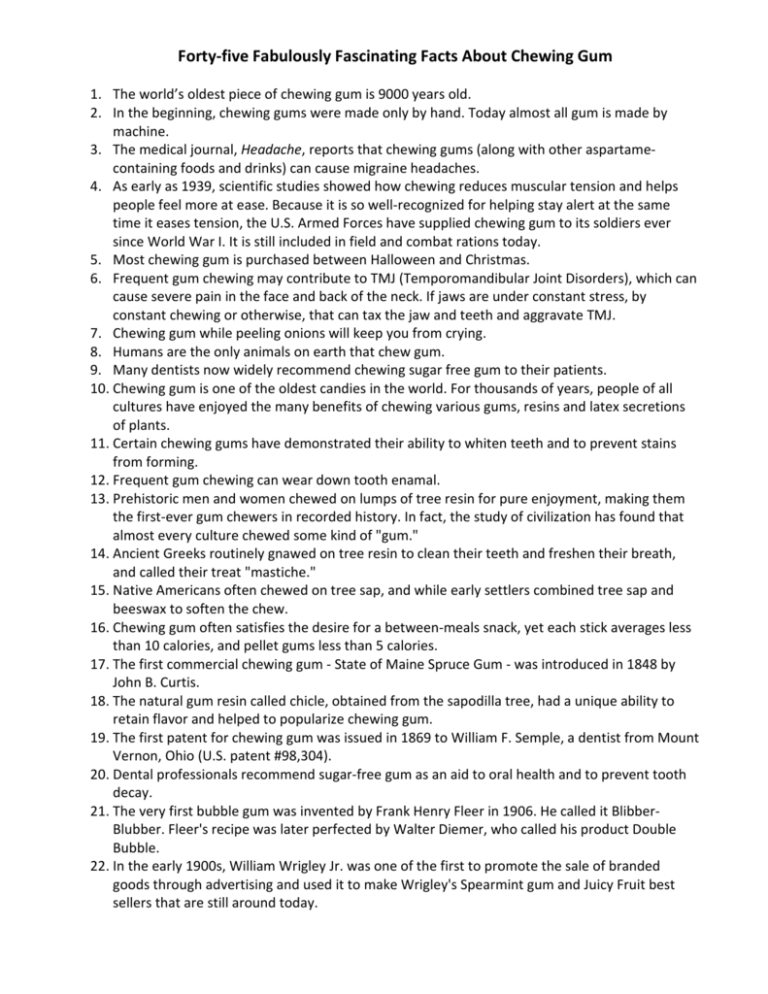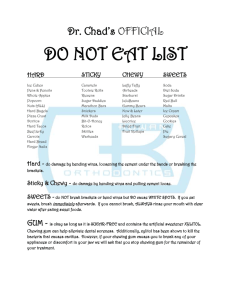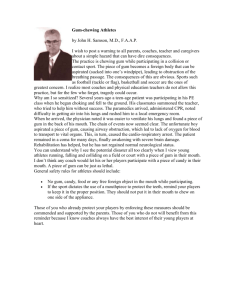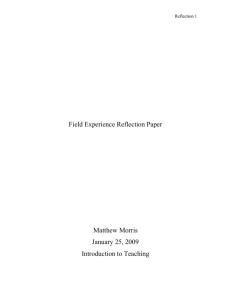Forty-five Fabulously Fascinating Facts About Chewing Gum
advertisement

Forty-five Fabulously Fascinating Facts About Chewing Gum 1. The world’s oldest piece of chewing gum is 9000 years old. 2. In the beginning, chewing gums were made only by hand. Today almost all gum is made by machine. 3. The medical journal, Headache, reports that chewing gums (along with other aspartamecontaining foods and drinks) can cause migraine headaches. 4. As early as 1939, scientific studies showed how chewing reduces muscular tension and helps people feel more at ease. Because it is so well-recognized for helping stay alert at the same time it eases tension, the U.S. Armed Forces have supplied chewing gum to its soldiers ever since World War I. It is still included in field and combat rations today. 5. Most chewing gum is purchased between Halloween and Christmas. 6. Frequent gum chewing may contribute to TMJ (Temporomandibular Joint Disorders), which can cause severe pain in the face and back of the neck. If jaws are under constant stress, by constant chewing or otherwise, that can tax the jaw and teeth and aggravate TMJ. 7. Chewing gum while peeling onions will keep you from crying. 8. Humans are the only animals on earth that chew gum. 9. Many dentists now widely recommend chewing sugar free gum to their patients. 10. Chewing gum is one of the oldest candies in the world. For thousands of years, people of all cultures have enjoyed the many benefits of chewing various gums, resins and latex secretions of plants. 11. Certain chewing gums have demonstrated their ability to whiten teeth and to prevent stains from forming. 12. Frequent gum chewing can wear down tooth enamal. 13. Prehistoric men and women chewed on lumps of tree resin for pure enjoyment, making them the first-ever gum chewers in recorded history. In fact, the study of civilization has found that almost every culture chewed some kind of "gum." 14. Ancient Greeks routinely gnawed on tree resin to clean their teeth and freshen their breath, and called their treat "mastiche." 15. Native Americans often chewed on tree sap, and while early settlers combined tree sap and beeswax to soften the chew. 16. Chewing gum often satisfies the desire for a between-meals snack, yet each stick averages less than 10 calories, and pellet gums less than 5 calories. 17. The first commercial chewing gum - State of Maine Spruce Gum - was introduced in 1848 by John B. Curtis. 18. The natural gum resin called chicle, obtained from the sapodilla tree, had a unique ability to retain flavor and helped to popularize chewing gum. 19. The first patent for chewing gum was issued in 1869 to William F. Semple, a dentist from Mount Vernon, Ohio (U.S. patent #98,304). 20. Dental professionals recommend sugar-free gum as an aid to oral health and to prevent tooth decay. 21. The very first bubble gum was invented by Frank Henry Fleer in 1906. He called it BlibberBlubber. Fleer's recipe was later perfected by Walter Diemer, who called his product Double Bubble. 22. In the early 1900s, William Wrigley Jr. was one of the first to promote the sale of branded goods through advertising and used it to make Wrigley's Spearmint gum and Juicy Fruit best sellers that are still around today. 23. A UK study by the University of York Health Economics Consortium investigating the economic impact of chewing sugarfree gum concluded that if the entire British population chewed sugarfree gum, the National Health Service (NHS) could save over $100 million per year on dental care. 24. During WWII, U.S. military personnel spread the popularity of chewing gum by trading it and giving it as gifts to people in Europe, Africa, Asia and around the world. 25. Spearmint, peppermint and cinnamon are among the most popular flavors of chewing gum today. 26. Fortified gum provides a convenient way of taking vitamins and minerals. 27. Chewing gum can cause unwanted interactions with drugs. For example, calcium channel blockers administered under the tongue were ineffective with gum chewers. Procardia, another drug, was almost totally ineffective with gum-chewing patients. 28. Chewing gum provides assistance to those who are trying to give up smoking. 29. By 1888, an Adams' chewing gum called Tutti-Frutti became the first to be sold in a vending machine. The machines were located in New York City subway stations. 30. The color of the first successful bubble gum was pink, because it was the only color the inventor had left, and that remains the predominant color today. 31. The largest bubble ever blown was 23 inches in diameter. The record was set July 19, 1994 by Susan Montgomery Williams of Fresno, California. (Guinness Book of World Records 1998). 32. The country with the largest number of chewing gum manufacturers is Turkey, with more then 60 producers. 33. London, which has crusaded against street-stuck gum in advance of the 2012 Olympics, spent three months steam-cleaning 300,000 pieces of gum off fewer than two miles of street. A piece of gum costs Londoners just a nickel. It cost the city up to a bit more than $3 to remove each wad from the pavement. 34. Chewing sugar-flavored gum bathes the teeth in sugar and will promote dental decay and the other problems associated with high sugar intake. 35. There are more than 1,000 varieties of gum manufactured and sold in the Untied States. 36. The longest gum wrapper chain on record was 7,400 feet in length (nearly one and a half miles) and was made by Cathy Ushler of Redmond, Washington between 1969 and 1992. 37. Chewing gum moistens and refreshes the mouth and throat and sweetens the breath. 38. Sugarless or sugar-free gums first entered the marketplace in the early 1950s. 39. Worldwide, humans chew about 560,000 tons of gum each year, according to one study. 40. Chewing gum is not biodegradable. 41. Chewing gum consumption varies by geography. In the U.S., people chew an average of 182 stick equivalents per person per year. In the U.K., the figure is 125 - it’s 103 in Germany, 84 in Russia, 20 in China, and 4 in India. 42. During his playing career, Michael Jordan would regularly chew Doublemint gum during basketball games to help him concentrate. 43. Chewing gum can improve memory, say UK psychologists. They found that people who chewed throughout tests of both long-term and short-term memory produced significantly better scores than people who did not. 44. Dave Grohl, founder and lead singer of the Foo Fighters, chews gum while performing, because he feels it keeps his mouth moist and his vocal chords fresh. 45. Chewing gum does not satisfy snack cravings. It may do the opposite. One experiment found that chewing gum, sweetened with aspartame, increases hunger. Furthermore, if you chew gum for extensive periods while not eating, that process of chewing causes digestive enzymes to be produced. “In time, the pancreas can become stressed, produce fewer enzymes, and digest foods less efficiently. This sequence can lead to health problems.”






